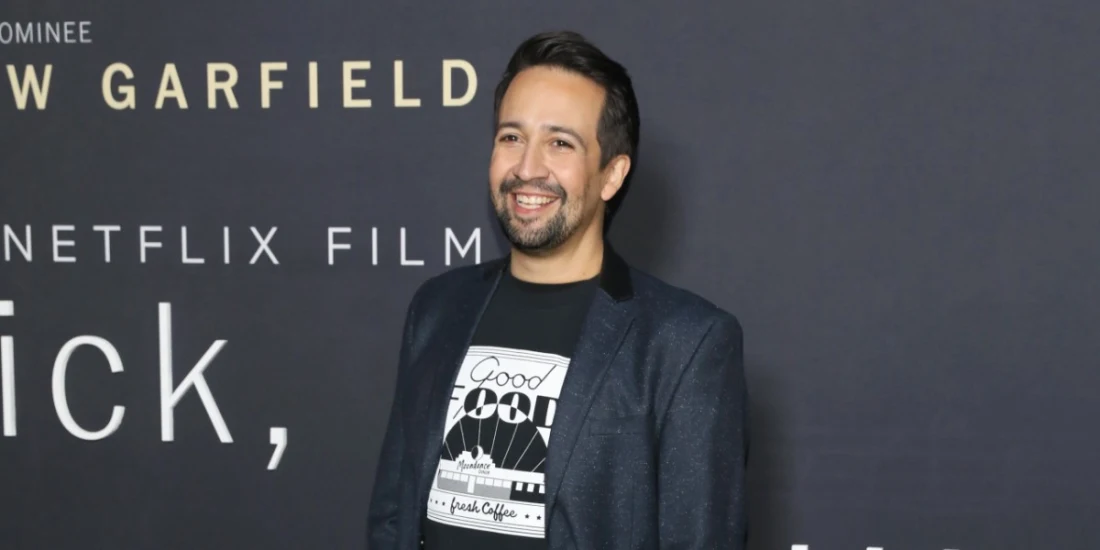Lin-Manuel Miranda on coming full circle with directing 'tick, tick... BOOM!'
Directing tick, tick... BOOM!, the Netflix film adaptation of Jonathan Larson's 1990 musical, was at once a familiar and unfamiliar process for Lin-Manuel Miranda. The project marks his directorial debut, but it's by no means his first time on a film set, as he's fresh off the release of In the Heights, the film adaptation of his own 2007 musical, this past summer. (He's been involved in films like Mary Poppins Returns, Moana, Encanto, and Vivo as either a composer, lyricist, performer, or a combination of the three.) Not to mention that his work in theatre, as the creator of In the Heights and later Hamilton, prepared him well for the job of a director: having a clear vision, a specific story to tell, and seeing it through.
Rather than pulling together the notes and words of a story, however, this time Miranda was pulling together camera shots, old show footage, an all-star cast (led by Andrew Garfield as Jonathan Larson), and a host of Broadway cameos, all to deliver the semi-autobiographical story of the Rent composer. And that story of tick, tick... BOOM! is what was most familiar to Miranda. The film shows Larson putting his all into a different musical, a sci-fi rock show called Superbia that he'd worked on for eight years. In the days leading up to his 30th birthday, pressure and anxiety build as he feels like he's on deadline to succeed. It's hard to imagine, now that Miranda has a Pulitzer Prize and a dozen other awards to his name, but that struggle is something a once-aspiring Miranda related to, and what still resonates with him in retrospect.
Miranda spoke with New York Theatre Guide about how he sees himself in Larson, how he sees Larson in his own musicals, and how film directing and theatrical composing are similar.
Do you see any similarities between you and Jonathan Larson?
It's a full snake-eating-its-tail scenario, the fact that Jonathan Larson is the person who made me feel like I could write a musical. And in a lot of ways, his obsessions became my obsessions. I'm 17 years old, and I see him write about his community in New York facing gentrification [in Rent] — this portrait of love, of a community changing. And two years later, I'm writing In the Heights about a community on the brink of change and gentrification and how to portray your own community with love. And there's a lot of DNA between Jonathan Larson's fictional version of himself in tick, tick... BOOM!, and my fictional version of Alexander Hamilton. They're both writing like they're running out of time, and they both hear the ticking of that clock super loud, so it's impossible to overstate how much his work influenced mine.
And then on a more practical level, his firm belief that popular music and theatre music can be friends, just like [Oscar] Hammerstein said [in Oklahoma!] that "the farmer and the cowhand can be friends." I made my work about advancing that thesis with the music that I love, with hip hop music and Latin music. And now, to then get to use everything I've learned to tell Jonathan's story in this film — it's full circle.
With all that in mind, how did you approach this project, your directorial debut, differently from your past projects?
The most interesting thing to me was the things I've learned in making theatre and what was applicable, and how much of the same skill set was applicable. I've been on film sets — every project I've chosen since Hamilton has been the film school I couldn't afford as college. So getting to work with Rob Marshall, getting to watch John Chu direct [In the] Heights, getting to get in Bob Fosse and Gwen Verdon's brains on Fosse/Verdon just as a producer, and watching my best friend Tommy Kail make movies about a director who could not be more different than him. I think that all of that went into this experience.
The most surprising part was how much editing is analogous to building a score. When I'm writing a theatre score, I'm thinking about tempo and rise and fall and tension and release and surprise and how that exists in time over two hours. It's the exact same questions you're asking yourself when you're editing the contours of a film. The only difference is the tools you're using — it's editing equipment instead of the piano. But that was like, "Oh, I actually know the questions I'm supposed to be asking in this part of the process." And that was the part I was least familiar with.
What about Larson's legacy meant the most to you that you hope the film gets across?
What hit me hardest about tick, tick... BOOM! when I was 21 years old, and I saw Raúl Esparza do it at the Jane Street Theatre, was how it's really a story about failure and getting back up again. This is not the biopic where you see the genius behind Rent writing Rent. This is a story about someone who spent his 20s writing a musical no one wanted to produce, and how do you recover? How do you get back up? How do you attack the blank page again? I think that speaks to people no matter where they are in life. How do you get back up and start making the next thing and and continue to figure out how to do what it is you love, even if 99 percent of the time you're not going to get paid to do the thing you love? You have to make space and room for it. And that's the part that I take with me.
Photo credit: Getty for Netflix
Originally published on
